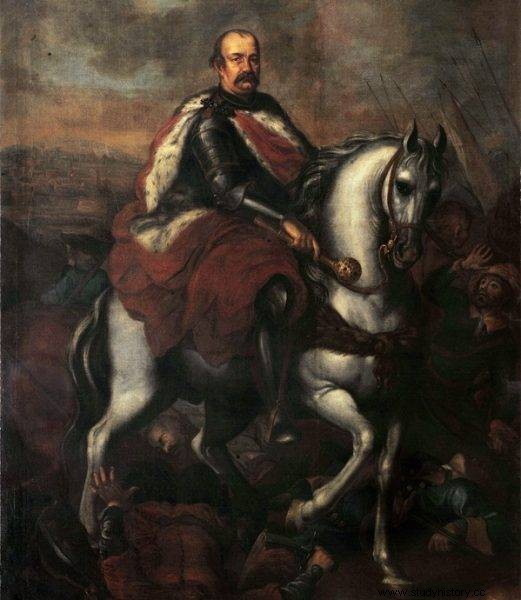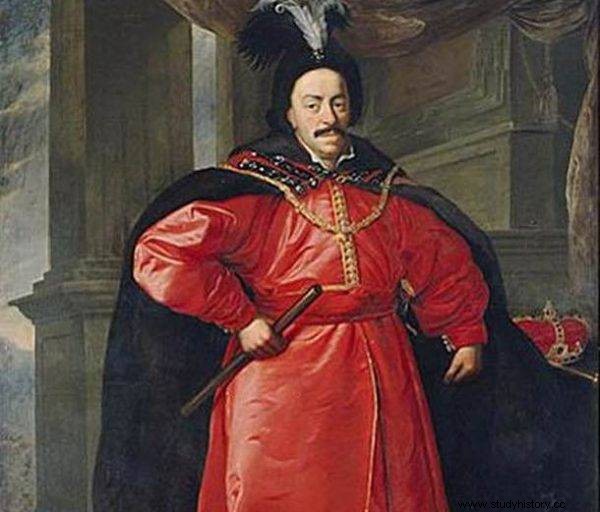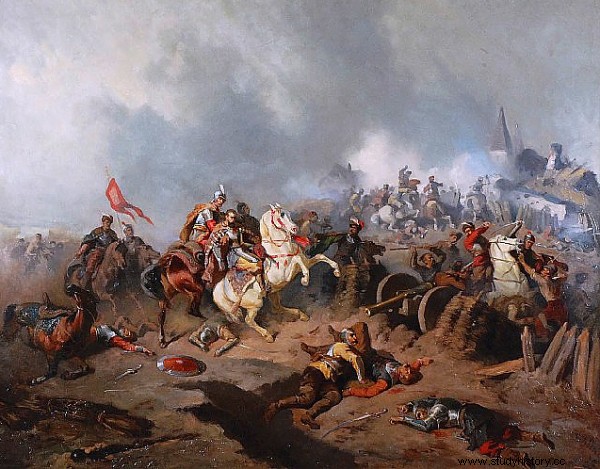After decades of bloody wars with the Turks, Tatars, Moscow, and Cossacks, right after the dramatically devastating Swedish invasion, the Polish nobility treated the Republic of Poland with a civil war. Its bloodiest and most embarrassing episode was the Battle of Cuttlefish in 1666. To this day, it is considered one of the darkest events in our history.
The Swedish Deluge, which overwhelmed the Polish nobility in the years 1655–1660, turned out to be extremely devastating for the state. The country is on the brink of collapse. The war with the invader from the north resulted in a loss of about 30 percent. people, agriculture was ailing, there were famines. Society was pauperized, enemies stole as much as they could. They wiped entire cities off the face of the earth.
To make matters worse, the economic and social crisis coexisted with increasing anarchy and inefficiency of the royal power functioning in the pathological system of the oligarchy.
This is what King Jan Kazimierz tried to change - first of all, he wanted to break with free election and introduce the election of the king while the current ruler was still alive ( vivente rege This was, among other things, to prevent the years of interregnum from devastating the state. Such a system would also facilitate the succession to the throne. A similar maneuver was used earlier by Zygmunt the Old, forcing his son, Zygmunt August, to the throne. After his death, as a result of a sharp conflict with the nobility, Henrician articles were adopted, blocking the possibility of such an election in the future.
When after vivente rege Jan Kazimierz tried to reach for him, an alliance of some of the nobility and the army was formed against him, led by Field Hetman of the Crown, Jerzy Lubomirski. This talented commander quickly assembled a sufficient number of soldiers ready to go under his command. He had the reputation of a great leader. In any case, undoubtedly - not only was he instrumental in expelling the Swedes from the country, but also defeated the Cossack-Russian alliance in the Battle of Cudnow in 1660.
In 1664, senators from powerful families accused the hetman of treason, inciting the army and anti-royal conspiracy. The court, which did not even hide its partiality and dislike of the influential Lubomirski, sentenced him to banishment, loss of property and infamy.

Jerzy Lubomirski had the reputation of a great leader. In any case, undoubtedly - not only was he instrumental in expelling the Swedes from the country, but also defeated the Cossack-Russian alliance.
The degraded hetman fled abroad, specifically to Silesia. The mace after him was taken over by his former companion from the battlefield, whom Lubomirski saved his life some time ago. I am talking about Jan Sobieski. Lubomirski released him from captivity during the battle with the Cossacks at Beresteczek, where Sobieski was wounded. However, the former merits did not matter when it came to the current changes and personal arrangements. Sobieski sided with the king.
Meanwhile, Lubomirski, not without the help of foreign courts, obviously interested in keeping the Republic of Poland in conflict, managed to gather enough forces to demand justice with a saber. In 1665, in a manifesto, he proclaimed himself a defender of noble freedom, who fought against the "tyranny" allegedly introduced by the monarch. He called the nobility to revolt. This is how the anti-royal confederation was formed. It was the beginning of a fratricidal civil war.
One ferry too far
In July 1666, both sides stood against each other in the vicinity of the village of Mątwy (today a district of Inowrocław) on the Noteć River. It seemed that Jan Kazimierz would crush the rebels. He had all the trump cards in his hands. He had a larger army, a regular army with infantry and artillery, and reinforcements from abroad - incl. from France. He also had Tatar and Lithuanian troops under his command.
The result of the battle was influenced by the king's fatal error (committed, moreover, at the instigation of Hetman Sobieski). Jan Kazimierz decided to move his army to the other side of the Noteć. The ford on the river, however, was very narrow and dangerous, which delayed the passage. There were only a few riders in one row, and the water was deep in some places. So crossing the river turned into an advanced logistic operation.

photo:Daniel Schultz / public domain It seemed that Jan Kazimierz would crush the rebels. He had all the trump cards in his hands.
Nevertheless, the initial course of the clash did not herald a catastrophe. On the contrary - several hundred Lithuanians who were the first to cross the river, emerged victorious from a skirmish with a Confederate unit. After this episode, the ruler, along with Sobieski and the rest of the commanders, became convinced that the crossing area was safe and that the rebels were still far away. He was wrong - in fact, the Confederates were closely watching the course of events. They dragged all their forces over a nearby hill, realizing the opponent didn't know it.
A tragic mistake - this time by Sobieski - was also the setting up of the royal army after reaching the other bank. The ride under the command of the queen after defeating Noteć did not take place at the rear, so she pushed forward, standing in front of the dragoons. Thus, she cut them off from the possibility of firing, at the same time risking being trampled by her own horses if she had to retreat. It actually happened.
Unaware of the trap, the soldiers continued their march across the river when suddenly the ground shook. A Confederate cavalry crashed down on them from a nearby hill.
Murder of confreres
The attack was a complete surprise for the troops of Jan Kazimierz. Chaos broke into the ranks of the royal forces. Useless, cut off from fire, the dragoons were trampled by horses. Sobieski, at the head of two cavalry banners (about 1,000 men), tried to turn the tide and attacked the enemy, but was smashed. He had to save himself by running away. The rebels pushed him into the river. His horse was probably injured during the desperate crossing. He himself lost his sword and bow.
Those who did not manage to escape from the battlefield, mainly dragoons, died at the hands of the Confederates. The battle turned into slaughter. Some of the soldiers escaped from their countrymen to the nearby marshes. According to Sobieski himself, the Confederates committed a crime. They promised to spare the lives of those who would return and surrender, but in fact they killed prisoners in a cruel manner by hacking their sabers. There was no pity for the "gentlemen of the brothers." Hetman wrote to his beloved Marysieńka Zamojska:
On this occasion, the greatest deaths of people were that, as they escaped from the mud, they called them up, giving them quartier and parol, and then, having failed over the mountain, they did not cut, but art. Not only the Tatars, the Cossacks never did such tyranny, but in all the stories about such from the fattest nations no one read cruelty. They do not find one body, lest they have forty times in them, because after death they tormented bodies.

Many experienced and distinguished soldiers died at the hands of Polish hands, incl. Stefan Czarniecki (he himself did not take part in the fight, he died shortly before).
Today it is estimated that 2.5 thousand royal soldiers died at the hands of the Confederate - whether on the battlefield or in captivity. "It was a real slaughter, and at the same time the bloodiest battle in Poland in the 17th century," commented the historian, prof. Zbigniew Wójcik.
Jerzy Lubomirski formally won at Mątwy, but in fact the noble Republic lost. Many experienced and distinguished soldiers died by Polish hands - incl. Stefan Czarniecki (he himself did not take part in the fight, he died shortly before). There were no such people when it was necessary to defend the homeland again. Rokosz also successfully stopped the plan of reforms and the institutional strengthening of the country - so needed in a country that had been broken by more than half a century of wars.
The runaway king
After the defeat, Jan Kazimierz in the so-called In the Łęgonice settlement, he undertook to stop the reform. Two years later, he renounced the crown and left for France, thus ending the reign of the Vasa dynasty in Poland. In the country on the Seine, he was given the management of the very profitable Saint-Germain-des-Prés abbey.
The second of the heroes of this tragedy, Jerzy Lubomirski, regained his honor, but not the Hetman's mace. He did not come back from exile. A year later, he died in a foreign country.
After the abdication of Jan Kazimierz through free election the nobility chose the extremely inept and passive Michał Korybut Wiśniowiecki as king . It was another episode on the way to the fall of the Republic of Poland. Soon after, the eastern borders of the country were invaded by the Turks, separating the Kamieniec Podolski fortress from Poland.
Apparently, when the news of the fall of Kamieniec reached France, Jan Kazimierz suffered an attack of apoplexy and died. His cassander vision of the future of the country he was governing was just slowly being fulfilled. He predicted that if the monarchical power was not strengthened, the noble Republic would end in a sad end:
Moscow and Ruthenia will refer to the peoples of one of their languages and will designate Lithuania for themselves; the borders of Greater Poland will be open to the Brandenburger, and it should be presumed that [he] will want to certify [try] for all of Prussia, finally the Austrian House glancing greedily at Krakow will not miss an opportunity that is convenient for it and will not refrain from annexation with the widespread tearing down of the state.
These words, spoken in the Seym of 1661, when the king argued the necessity of introducing the vivente rege election , unfortunately turned out to be prophetic.
